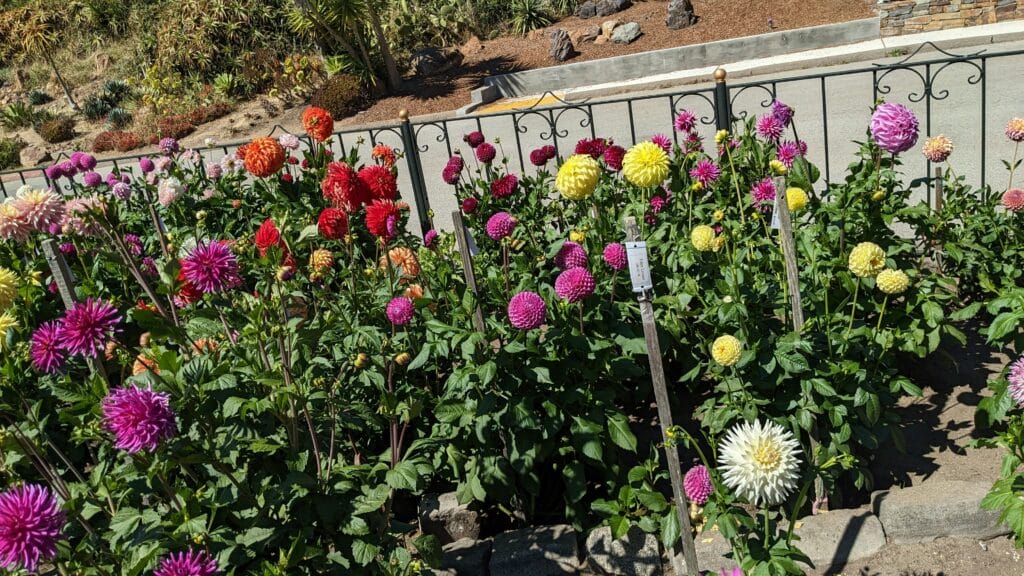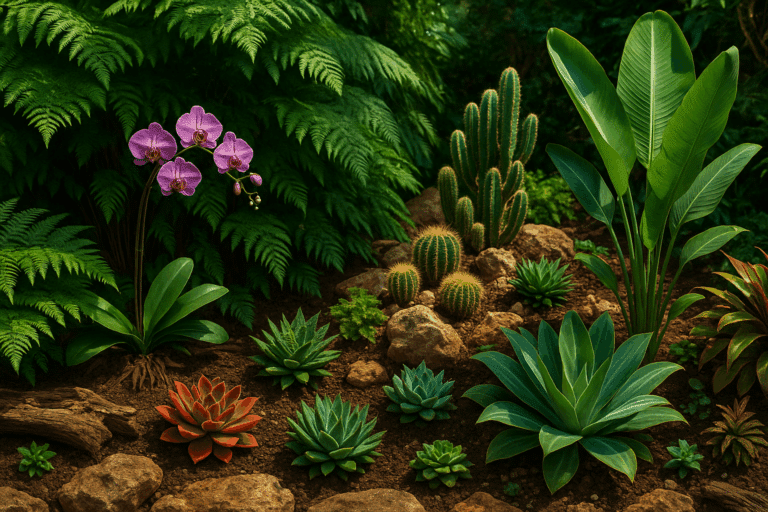Adaptable to various climates and exceptionally drought-resistant, this plant species is a perfect choice for gardeners seeking low maintenance yet attractive greenery. In this discussion, we’ll delve into the world of Sedum, also known as stonecrop, and learn why it’s the go-to ground cover for many gardening enthusiasts.
Endowed with soft textures and vibrant colors, Sedum ground cover can transform an ordinary garden into a stunning landscape. Not only does it enhance the aesthetic appeal, but it also serves a practical purpose, effectively preventing soil erosion and crowding out weeds. This dynamic dual purpose ensures Sedum is a prized jewel in the gardener’s toolbox.

As we explore the beauty and resilience of Sedum ground cover, we will uncover how to cultivate and care for these plants effectively. From understanding their growing conditions to learning about their propagation, we aim to equip you with knowledge that can turn any garden into a blooming Sedum sanctuary.
Join us on this horticultural journey as we dive deep into the world of Sedum. Whether you’re an experienced gardener or a novice with a budding interest in horticulture, the versatility and easy care of Sedum ground cover are sure to captivate your green thumb. Let’s uncover the wonders of this plant species together.
The Features of Sedum Ground Cover
Sedum ground cover, also known as stonecrop, belongs to a large genus of flowering succulent plants that are incredibly versatile, hardy, and aesthetically pleasing. These plants are best known for their remarkable ability to thrive in diverse environmental conditions, especially in dry, nutrient-poor soils where many other plants fail to flourish. Their resilience makes them a popular choice for both novice gardeners and professional landscape designers.
One of the primary features of Sedum is its outstanding drought resistance. These succulents have evolved specialized, thick leaves capable of storing water, allowing them to survive extended periods without rainfall. During hot summer months or dry spells, when many plants begin to wilt or brown, Sedum remains lush and vibrant, offering a dependable source of greenery and color. This characteristic makes them especially suitable for regions with limited rainfall or where water conservation is a priority.
In addition to drought resistance, Sedum is also known for its ability to tolerate poor soil conditions. Whether grown in rocky, sandy, or clay soils, these plants adapt with ease, reducing the need for soil amendments or fertilizers. Their low nutrient requirements further contribute to their sustainability, minimizing environmental impact.
The Range of Sedum Species
There are approximately 400 species within the Sedum genus, encompassing an extraordinary range of forms, sizes, and colors. This diversity allows gardeners to select the perfect variety for almost any garden setting, from tiny alpine rock gardens to expansive meadow-style plantings.
Some Sedum species are low-growing creepers that hug the ground and spread horizontally, forming dense mats ideal for covering bare soil or replacing traditional grass lawns. These are often used along pathways, between stepping stones, or on green roofs. Others are upright varieties, growing up to 24 inches or more, that add height and structure to perennial beds and borders.
The foliage varies widely in shape and color—ranging from tiny, needle-like leaves to broad, fleshy rosettes in shades of green, blue, burgundy, and even gold. Many varieties produce beautiful star-shaped or bell-like flowers in hues of yellow, pink, red, or white. These blooms not only enhance visual appeal but also attract pollinators such as bees, butterflies, and beneficial insects, adding biodiversity to the garden.
The Benefits of Planting Sedum Ground Cover
Sedum ground cover offers a multitude of benefits for home gardens, public landscapes, and commercial properties alike. One of its most valuable traits is its compatibility with xeriscaping—a landscaping philosophy that focuses on water-efficient gardening. Because Sedum requires very little irrigation once established, it helps reduce water consumption and supports sustainable landscape practices.
Additionally, Sedum plays a vital role in soil stabilization and erosion control. Its shallow but extensive root system helps anchor the soil, making it particularly effective on slopes, embankments, and other erosion-prone areas. Its dense foliage also acts as a living mulch, suppressing weeds and protecting the soil from sun, wind, and heavy rainfall.
From an aesthetic perspective, Sedum provides year-round interest. Many species change color with the seasons, offering shifting palettes of greens, purples, oranges, and reds. Even in winter, the dried seed heads of taller varieties can add structural beauty to dormant gardens.
Lastly, Sedum requires minimal maintenance. It rarely needs pruning, seldom suffers from pest infestations or diseases, and doesn’t demand frequent fertilizing. For anyone seeking a plant that combines beauty, durability, and environmental friendliness, Sedum ground cover stands out as a top contender.
Eco-Friendly and Low Maintenance
Sedum plants are widely praised for their minimal care requirements, making them an eco-friendly and sustainable option for modern gardens. Once established, these succulents thrive with little intervention. They rarely require pruning, tolerate periods of drought, and flourish in a range of soil conditions. Their natural resistance to many common pests and diseases eliminates the need for chemical pesticides, reducing your garden’s ecological footprint.
Because of their exceptional hardiness, Sedum is a favorite among those who want a thriving, beautiful landscape without investing significant time in upkeep. Even during dry spells or poor weather, these plants maintain their vibrant appearance, proving to be both reliable and durable. This makes them especially beneficial for busy homeowners, elderly gardeners, or those maintaining vacation properties.
Additionally, Sedum contributes significantly to soil health and protection. Their robust root systems hold the soil together effectively, helping to stabilize slopes and embankments. Their dense foliage forms a living mulch that shields the ground from heavy rainfall and wind erosion. In this way, Sedum not only beautifies an area but also plays a vital role in ecological conservation and land management.
Popular Varieties of Sedum Ground Cover

With hundreds of cultivars available, Sedum offers an astonishing range of choices in texture, color, and growth habit. This versatility allows gardeners to design spaces with diverse visual interest throughout the seasons. Some standout varieties include:
- Sedum acre: Also known as goldmoss stonecrop, this fast-spreading variety produces a lush mat of bright green foliage topped with tiny, star-shaped yellow flowers in summer. It’s ideal for rocky soil and hot, dry conditions.
- Sedum reflexum: Commonly referred to as blue spruce stonecrop, this variety resembles conifer foliage with its needle-like, bluish-green leaves. It brings a unique, evergreen texture to gardens and produces clusters of yellow blooms.
- Sedum spurium: Known as two-row stonecrop, it features deep green to reddish foliage with lovely pink or red flowers. It spreads easily and thrives in both full sun and partial shade, making it perfect for filling large areas, borders, or container gardens.
- Sedum sexangulare: A lesser-known but beautiful option, this variety forms tight, dense mats of cylindrical leaves and bears yellow flowers. Its name refers to the six spiral rows of leaves around its stem.
- Sedum kamtschaticum: This variety offers a rich, green carpet of scalloped leaves and produces clusters of golden-yellow flowers in summer. In autumn, its foliage often turns a reddish hue, adding seasonal interest.
Whether used alone or mixed for contrast, these varieties can transform a space into a vibrant, low-maintenance paradise. Their adaptability, beauty, and sustainability make Sedum a go-to plant for both novice gardeners and seasoned landscape designers.
Sedum in Landscape Design
Given their diverse array of colors, sizes, and forms, Sedum plants—also known as stonecrops—are incredibly versatile in landscape design. These succulent perennials can be used in a wide variety of ways, from filling gaps between pavers to creating expansive ground covers. Their ability to thrive in poor soils, their resistance to drought, and their tolerance for full sun make them an invaluable addition to low-maintenance gardens. Sedum is especially well-suited for xeriscaping, where water conservation is a key concern.
Their compact growth habits and striking textures make them ideal for rock gardens, where their architectural shapes can truly shine. The thick, fleshy leaves come in shades of green, blue, burgundy, and even variegated patterns, adding year-round interest. Many Sedum varieties also produce star-shaped flowers in late summer or early fall, attracting pollinators like bees and butterflies, further enhancing their value in an ecologically conscious garden design.
Creating a Sedum Carpet
For areas where grass struggles to grow—such as dry slopes, poor soils, or high-traffic zones—consider replacing traditional turf with a vibrant Sedum carpet. This not only results in a visually appealing, low-maintenance alternative to a lawn, but also contributes to environmental benefits. Sedum roots help bind the soil, reducing erosion, while their dense foliage helps to suppress weeds naturally, decreasing the need for chemical herbicides.
In urban settings, Sedum is often chosen for green roofs because of its shallow root system, heat tolerance, and ability to survive with minimal care. These living roofs improve insulation, reduce stormwater runoff, and contribute to biodiversity in otherwise sterile environments.
Overall, Sedum ground cover is an excellent choice for any gardener or landscape designer seeking to add beauty, sustainability, and resilience to outdoor spaces. With its ability to thrive in harsh conditions, its incredibly low maintenance needs, and its vast range of colors and forms, Sedum offers something unique for everyone. Whether you’re a seasoned gardening veteran or a complete novice, Sedum is a plant worth exploring and incorporating into your outdoor sanctuary.
Why Sedum Ground Cover Is a Smart and Beautiful Choice for Any Landscape
In summary, Sedum ground cover represents one of the most adaptable, sustainable, and visually engaging plant options available in modern landscaping. From its drought-resistant characteristics to its diverse range of species and practical benefits, Sedum offers unmatched value for gardeners and designers looking to create resilient, low-maintenance outdoor spaces.
One of the most compelling arguments in favor of Sedum is its remarkable environmental resilience. These hardy succulents thrive in conditions that would typically challenge or kill other plants. Whether you’re working with rocky soils, sloped terrains, or regions with limited rainfall, Sedum can endure and even flourish, making it ideal for xeriscaping and other sustainable gardening approaches.
Equally important is its aesthetic diversity. With over 400 species to choose from, ranging in height, texture, and color, Sedum enables the creation of rich, layered landscapes. Gardeners can mix and match varieties for seasonal interest and visual harmony, using low-growing types as vibrant carpets or taller types as structural highlights. Whether your design leans toward minimalist rock gardens, whimsical pollinator habitats, or sleek green roofs, there’s a Sedum that will complement the vision.
The ecological benefits are also noteworthy. Sedum supports biodiversity by attracting pollinators, helps control erosion with its extensive root systems, and suppresses weeds naturally through dense growth. Its resistance to pests and diseases further reduces the need for chemical treatments, promoting a healthier garden environment.
Finally, the low maintenance requirements of Sedum make it highly accessible. It’s a perfect choice for those with limited time, physical limitations, or a desire to reduce the labor involved in garden upkeep—without sacrificing beauty or functionality.
Altogether, Sedum isn’t just a plant—it’s a strategic solution for sustainable landscaping. Its combination of form, function, and environmental benefits ensures that it will remain a timeless favorite among home gardeners and professional designers alike. Whether you’re revamping a small corner of your yard or planning a large-scale ecological installation, Sedum ground cover is a decision you won’t regret.
Conclusion
In conclusion, Sedum ground cover truly offers an exceptional blend of charm and practicality for your garden. Their soft and delicate appeal, combined with their resilience to drought, makes them an attractive, low-maintenance solution. As versatile ground cover plants, they seamlessly fill in the spaces between larger plants, providing an impressive display of colors, shapes, and textures that can captivate any onlooker.
The magic of Sedum lies not only in their visual appeal but also in their environmental adaptability. They thrive in a variety of climates and soils, proving that beauty does not always require high maintenance. Furthermore, their unique ability to store water in their leaves, making them drought-resistant, is a sustainable choice for water conservation in our gardens.
Adding Sedum to your garden is more than just planting – it’s a commitment to Mother Nature, contributing to biodiversity and ecosystem health. Their benefits extend beyond the garden, attracting pollinators, which play a crucial role in the environment.
Indeed, the beauty of Sedum ground cover goes beyond its soft and resilient characteristics. Its contribution to the environment and low maintenance needs, make it an excellent choice for any garden. So, why not discover the beauty of Sedum for yourself and see your garden transform into a captivating, eco-friendly oasis. 🌿🌼



